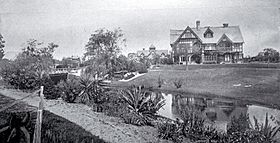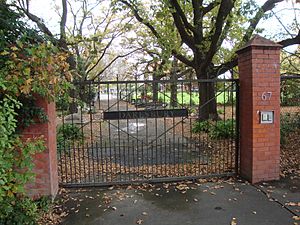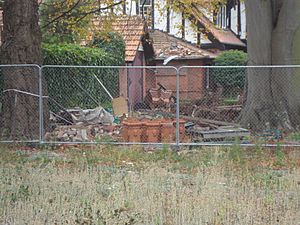Daresbury (house) facts for kids
Quick facts for kids Daresbury |
|
|---|---|

Daresbury Rookery in 1902
|
|
| Former names | Daresbury Rookery |
| General information | |
| Type | Residential home |
| Architectural style | Arts and Crafts movement |
| Location | Fendalton |
| Address | 67 Fendalton Road (front entrance) 9 Daresbury Lane (rear entrance) |
| Town or city | Christchurch |
| Country | New Zealand |
| Coordinates | 43°31′18″S 172°36′20″E / 43.5217°S 172.6055°E |
| Construction started | 1897 |
| Completed | 1901 |
| Renovated | 2009/10 |
| Owner | Libby and Denver Glass |
| Technical details | |
| Structural system | triple brick, with upper stories half-timbered |
| Floor count | three |
| Design and construction | |
| Architect | Samuel Hurst Seager |
| Awards and prizes | Christchurch Horticultural Society garden competition (1932) Supreme Award of the Christchurch Civic Trust (2010) |
| Designated: | 2 April 1985 |
| Reference #: | 3659 |
Daresbury, also known as Daresbury Rookery, is a beautiful and historic house in Christchurch, New Zealand. It is one of the city's most impressive homes. The house was designed by a famous architect, Samuel Hurst Seager. He created it in a style called English Domestic Revival.
Contents
History of Daresbury House
Daresbury was designed by Samuel Hurst Seager for a person named George Humphreys. George Humphreys was a merchant who sold wine and spirits. The house was built between 1897 and 1901. Many people think it is Seager's best large house design.
When it was first built, Daresbury sat on a very large piece of land. This land was about 10 hectares (which is like 25 acres). It was originally part of the land owned by the Deans family. The house was made even bigger until 1910. At that time, it had 50 rooms and five staff members who lived there.
Why "Rookery"?
In 1862, Jane Deans planted 100 blue gum trees on the property. Birds called rooks made their nests in these trees. This is why the house was first named Daresbury Rookery.
However, the trees later became sick from tiny wasps. The rooks left the property in the 1930s. A big snow storm in 1945 also damaged the trees. The very last blue gum tree was cut down in 1952.
Changes Over Time
Between 1940 and 1950, Daresbury was a very important place. It was the official home for the Governor-General of New Zealand. The Governor-General is like the Queen's representative in New Zealand.
Over the years, parts of the land were sold off. In 1954, 20 sections of the land were sold. Today, the house sits on a smaller piece of land, about 0.91 hectares (about 2.25 acres).
The house stayed in the same family until 1985. Later, it was owned by Libby and Denver Glass. They had to sell it, but then they bought it back in 2008.
Earthquake Damage
The Glass family had made the house stronger to protect it from earthquakes. However, Daresbury was still damaged in the 2010 Canterbury earthquake. One of its six large chimneys fell through the roof. The other chimneys had to be removed by a crane to keep the house safe.
Heritage Status
Daresbury is a very important historical building. On April 2, 1985, it was officially listed as a heritage building. This was done by the New Zealand Historic Places Trust. It was given a high rating, meaning it is a very important historical place.
Design and Awards
Daresbury is a great example of the English Domestic Revival style. This style is also known as the Arts and Crafts movement. Houses in this style often look like traditional English country homes. Daresbury is built with three layers of bricks, making it very strong. The upper parts of the house have a half-timbered look. This means they have wooden beams on the outside, with plaster or brick in between.
Daresbury has won awards for its beauty. In 1932, its garden won a competition from the Christchurch Horticultural Society. In 2010, the house won the Supreme Award from the Christchurch Civic Trust. This award was for how well the house was restored and updated. The award ceremony happened just a few weeks after the 2010 Canterbury earthquake caused damage to the house.



